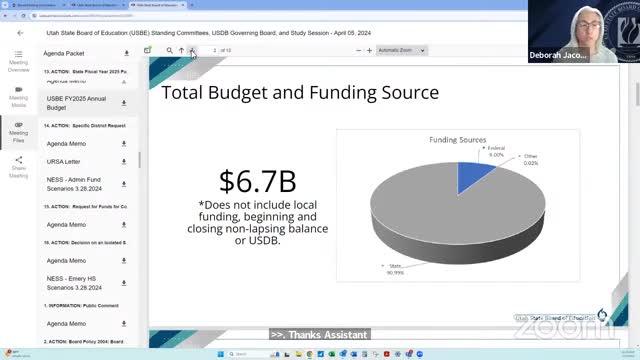Budget reveals major shifts in education funding allocations
April 05, 2024 | Utah State Board of Education, Utah Education, State Agencies, Organizations, Utah Executive Branch, Utah

This article was created by AI summarizing key points discussed. AI makes mistakes, so for full details and context, please refer to the video of the full meeting. Please report any errors so we can fix them. Report an error »

During a recent government meeting, officials discussed the intricacies of the current budget, which totals approximately $6.7 billion, significantly lower than the $8 billion appropriation due to the exclusion of local revenues and certain funding sources. The meeting highlighted that over 90% of the budget is derived from state funding, with only 9% coming from federal sources, a figure that may fluctuate due to ongoing COVID-related funding.
The budget includes nine new programs, primarily funded through one-time allocations totaling $3 million, with an additional $2 million designated for ongoing expenses. Key areas impacted by these new programs include student support services and teaching and learning initiatives.
A notable point of discussion was the allocation of $100 million for property insurance, which is a one-time request aimed at ensuring adequate funding for potential liability issues. Officials clarified that this funding will not be requested again in future budgets, as it is intended to remain in the insurance pool for any necessary claims.
The meeting also addressed various changes to existing programs, including increases in funding for basic programs and the reallocation of $1 million from the Rural Schools Transportation Grants Program to the NEST program. Additionally, $30 million was allocated for public education capital projects, and $100 million was earmarked for implementing school safety amendments.
Overall, the meeting provided a comprehensive overview of the budget's structure, emphasizing the flow of funds primarily directed towards local education agencies and community-based organizations, with minimal retention within the agency itself. The officials also introduced a new dashboard for public access to detailed budget information, enhancing transparency regarding funding allocations and program specifics.
The budget includes nine new programs, primarily funded through one-time allocations totaling $3 million, with an additional $2 million designated for ongoing expenses. Key areas impacted by these new programs include student support services and teaching and learning initiatives.
A notable point of discussion was the allocation of $100 million for property insurance, which is a one-time request aimed at ensuring adequate funding for potential liability issues. Officials clarified that this funding will not be requested again in future budgets, as it is intended to remain in the insurance pool for any necessary claims.
The meeting also addressed various changes to existing programs, including increases in funding for basic programs and the reallocation of $1 million from the Rural Schools Transportation Grants Program to the NEST program. Additionally, $30 million was allocated for public education capital projects, and $100 million was earmarked for implementing school safety amendments.
Overall, the meeting provided a comprehensive overview of the budget's structure, emphasizing the flow of funds primarily directed towards local education agencies and community-based organizations, with minimal retention within the agency itself. The officials also introduced a new dashboard for public access to detailed budget information, enhancing transparency regarding funding allocations and program specifics.
View full meeting
This article is based on a recent meeting—watch the full video and explore the complete transcript for deeper insights into the discussion.
View full meeting

